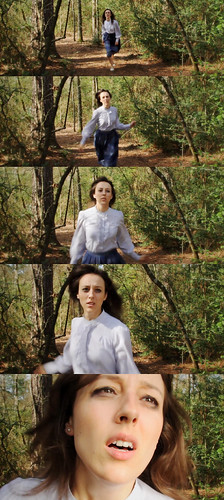
Britt Ragsdale, Still from Duet
If you have been following Britt Ragsdale's work over the past few years, the video work in Playback, curated by Paul Middendorf, won't be a big surprise. Ragsdale has been playing around with movie tropes since at least 2010. One of her Duets was in the Big Show in 2011. That same year, she started taping Screen Test, in which people mimed getting shot, Hollywood style. 2013's Scream Queens had actresses lip-synching famous horror movie screams.

Britt Ragsdale, stills from The Chase
The Chase is the most prominent piece in Playback. In it, we see a young woman wearing a white shirt and a blue dress running toward the camera, looking at something offscreen, and gasping. Then she gathers herself, walks back to the starting point and repeats the action. It's done over and over. The highly dramatic quality of the run towards the camera and gasp are totally mitigated by the repetition. If you are a film director, you see film this way all the time. You look at rushes completely stripped of actual drama and must sit around with your editor at the Avid trying to take these ridiculous scraps of nothingness and turn them into something that is convincing to a viewer. The Chase reminds you for a second that the drama is a result of acting and editing.
DUET (possessed) from Britt Ragsdale on Vimeo.
The Duet videos are related but take on the artifice of movies quite differently. They specifically refer to another key part of the feature film world, the still, and more particularly, the still images of couples kissing. In each of the Duet videos (there were four in the show), a male/female couple are posed in a stereotypical embrace, either mid-kiss or about to kiss or thinking about kissing. But these are videos, not stills. The couples don't move--they hold the cliched pose they're in instead of carrying out the implied action. I say they don't move, but that's actually not quite right. After all, they aren't statues. There are tiny movements made by each person as they attempt to remain in their respective poses. (These are long videos--if you watch them all the way through, you can see the poses gradually change as the actors become more fatigued.) These tiny movements show how weird and probably uncomfortable these poses are. They remind us, the viewers, how strange these film conventions are.
Another aspect of Duet worth noting is the utter ordinariness of the actors. The preternatural beauty of movie stars is so common that we often forget it. So when you put average looking people in a place usually occupied by Hollywood Olympians, it again draws your attention to the artificiality of the convention under examination--the screen kiss.

Britt Ragsdale, still from Don't Talk to Strangers
The last piece in Playback is a collage of found video and audio called Don't Talk to Strangers. Ostensibly a warning to girls and young women, it contains surreal rapid-fire editing of disparate images (all from the Prelinger Archive). It reminds me of A MOVIE (1958) by Bruce Connor. However, Don't Talk to Strangers feels like an echo of Connor's pioneering work. This kind of found footage collage is a standard exercise for film students (I remember doing one for Brian Huberman's film class at Rice), and things like the Prelinger Archive make it quite easy now to get raw material. Don't Talk to Strangers displays a lot of wit, but the Duets and The Chase are more interesting works.
The show is up at Fresh Art's Winter Street gallery until July 12, but if you can't see it there, many of the videos from Playback are viewable on Ragsdale's website.




No comments:
Post a Comment